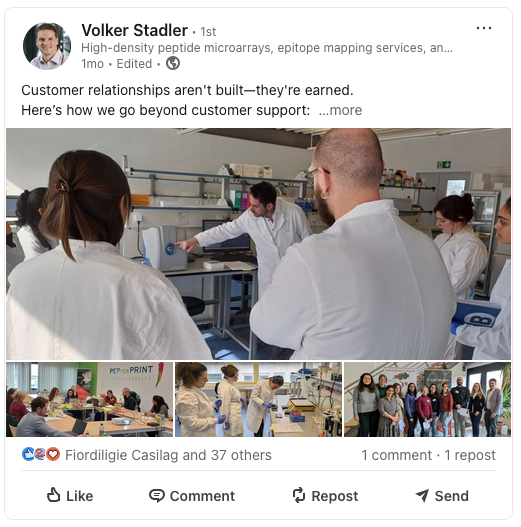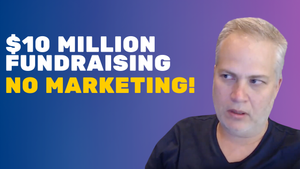Acquiring a customer is a milestone, but it's not the finish line. For scientific companies, the real work begins after the first deal is signed.
Building loyalty with your customers takes time and effort. The long-term success of your company might well depend on building trust and adding continuous value to your customer base.
Creating a customer-nurturing strategy is a lot of work, but fortunately, much of it can be automated. As with many aspects of your marketing, the key is to get the basics right and optimize with incremental improvements over time.
In this article, I’ll show you twelve proven tactics to help you transform first-time buyers into loyal advocates.
1. Create an email welcome series
The first impression matters. When a customer buys from you, don’t just send them your product without saying anything. Instead, create a structured email welcome series that introduces them to your brand, educates them on your solutions, and highlights your most useful content (make sure to collect emails and consent whenever a customer buys from you).
This could include:
- A note from the founder or a well-known scientific lead at your company explaining the vision of the company
- A customer case study that could inspire them on how to use your product
- A link to a previous webinar you recorded
- A helpful article from your website or a video tutorial on how to use your product.
The best is to combine all of those ideas into a series of 5-10 emails. Keep it spaced out over 4–6 weeks to avoid overwhelming them. This approach ensures new leads get value from the start and are more likely to convert into active users or buyers.
To make sure it always feels relevant, you can also segment your customers and send them specific content based on their research focus.
The welcome series is your first chance to make a great impression, so don’t overlook it.
2. Learn about them and their interests
To engage customers more effectively, you need to understand what matters most to them. The more you know about their interests, the better you can tailor content, product recommendations, and communication. This is where progressive profiling comes in.
Progressive profiling is the process of gradually collecting information about your customers over time.
Scientific companies can apply this by:
- Including a short survey after a new client signs up
- Using registration forms for webinars to ask about job role, research focus, or application areas
- Tracking content engagement to tag interests.
Over time, this data allows you to segment your audience, personalize your email campaigns and recommend relevant products.
For example, if a researcher indicates they work in cancer immunotherapy, you could tailor future messages to include related case studies, webinars, or product updates. By using progressive profiling, you also don't overwhelm your customer with lengthy surveys and keep the intrusion low over time.
3. Host customer-only webinars and live demos
Your existing customers are your most valuable audience. Instead of spending a lot of energy and budget on hosting webinars for a broad audience of potential leads, reward your existing customers with exclusive access to webinars and product demos tailored to their needs.
In these sessions, you can:
- Provide advanced training or troubleshooting
- Showcase new features or services before they go public
- Offer a platform for Q&A with your scientific team.
A webinar doesn't have to attract hundreds of people to be successful. A few of your existing customers gathered in a private setting could be the most engaged webinar you've ever had.
And if you record them, they also become reusable content for onboarding or customer support.
4. Offer in-lab training sessions
If your product requires hands-on use, like instruments or specialized kits, nothing beats in-person training. Invite customers to your lab or send your team to theirs to spend a few hours of quality time using the newly acquired equipment.
This tactic has multiple benefits:
- Help users get the most out of your tools
- Build personal relationships
- Show your technical expertise.
They also give your team valuable feedback on real-world usage and can uncover new opportunities or pain points. You can also ask your customers to bring their own project and help them get started during the live training.
One of my customers, PEPperPRINT, does exactly that. Once a year, they organize the PEPcademy, during which their customers can come to the lab and spend a day training on their peptide microarray.
It requires some organization, but the customers love it.

5. Ask for a case study
Case studies are powerful tools to demonstrate your product's real-world impact. But they’re also an opportunity to deepen your relationship with customers. When you ask a customer to be featured in a case study, you're recognizing their work and expertise.
The key is to make the process easy:
- Do the heavy lifting: draft the outline, write the first version, and handle approvals
- Focus on outcomes and challenges solved, nobody wants to read a lengthy case study without clear results
- Get quotes and permission to use names.
Many scientists appreciate the visibility, especially if it contributes to their professional reputation, so don’t miss the opportunity to build relationships and strong marketing assets at the same time.
6.Ask for testimonials
Not every customer wants to be in a full case study, but many are happy to give a short testimonial you can feature on your website or marketing materials.
To collect testimonials:
- Ask shortly after a positive milestone (like a successful project)
- Offer prompts or pre-made examples
- Make it easy to respond (e.g., via email or form).
Don’t underestimate the power of a good quote, especially from a respected peer in the field.
7. Highlight customers on LinkedIn
LinkedIn is the best platform to connect with your customers. Use it to showcase them, their research, their wins, or quotes they shared with you.
Use any opportunity to mention them, for instance if they join one of your webinar, create a short video clip highlighting their appearance. Give them a shout-out when they publish new research or when their business reaches an important milestone like a fundraising or partnership deal.
LinkedIn doesn’t always have to be about you. Make it about them, these small gestures show that you care and will also keep you top-of-mind in their network.
8. Set up a customer advisory board
A customer advisory board is a group of trusted customers who offer feedback on your roadmap, messaging, and strategy. It’s a win-win: they get early access and influence; you get insights and loyalty.
To make it work:
- Select 5–8 highly engaged customers from diverse backgrounds
- Meet 2–3 times per year, virtually or in person
- Prepare focused topics and follow up on suggestions.
Scientific companies often have a science advisory board, but rarely a customer board. This is a missed opportunity as it could help you improve the value of your offer while making your customers feel like they are part of your journey.
9. Build a referral program
Word-of-mouth is incredibly powerful in scientific communities. Scientists trust their peers more than they trust vendors. A referral program rewards existing customers for spreading the word.
Keep it simple, and offer a discount or bonus for both the referrer and the new customer. Promote it regularly in emails and make it as simple as possible for a customer to send you a referral (an email introduction could be enough, no need for a fancy system).
Referrals help you acquire highly qualified leads that come into your funnel with added trust, and it’s low-effort on your side.
10. Build a newsletter that adds value
A newsletter is one of the most cost-effective ways to stay top of mind, but many company newsletters are either too promotional or too boring. Instead, focus on providing genuine value.
Include:
- Curated papers or industry news
- Tips for using your product more effectively
- Thought leadership content
- Customer stories or interviews
- Announcements of webinars or events.
Keep it clean, easy to skim and most importantly, consistent (a monthly newsletter is often enough for B2B). Your goal is simple: make it one of the few emails they actually look forward to, which means an email you would enjoy reading yourself.
11. Collaborate on joint studies
For companies that work closely with researchers, joint studies are a goldmine. Partnering with a customer to produce new data or publish results deepens the relationship and showcases your value.
For example, you can co-develop a method or write an application note together. You could also simply provide free equipment or services in order to publish the results in a scientific publication and gain in reputation (which will ultimately be worth more than the free stuff you gave away).
These collaborations increase credibility, generate content, and often lead to repeat business.
12. Build a community
Creating a space where your customers can connect with each other adds a new layer of engagement. Consider setting up a Slack workspace or a LinkedIn group where customers can:
- Ask questions and get peer advice
- Share tips and experiences using your products
- Engage around relevant research topics.
A well-run community builds loyalty, helps users solve problems faster, and gives you direct insight into what your customers care about. It also makes your brand more than just a vendor and transforms it into a hub.
Keeping a community active isn't easy, so make sure you have enough customers to bring on board, and assign someone on your team to actively post in the community to keep it alive.
How to put these tactics into practice?
Customer engagement isn’t just a support function, it’s a strategic priority. But how do you tie all twelve of these tactics together into something actionable?
The key is to treat customer engagement like a system, not a checklist.
That means starting with a plan:
- Who are your key customer segments?
- What content and channels do they prefer?
- What should their experience look like after the first purchase?
Once you have this strategy in place, much of the implementation can be automated—welcome emails, webinar invites, referral tracking, and even personalized content delivery.
But you can’t bypass the strategy planning. It takes time, focus, and a deep understanding of your audience to create an engagement plan that works.





